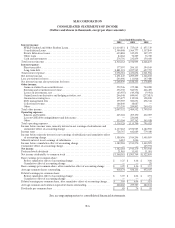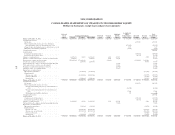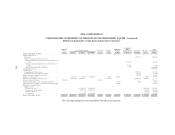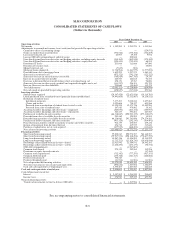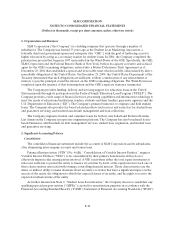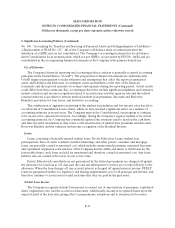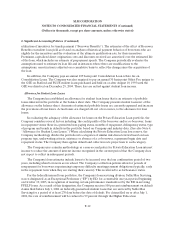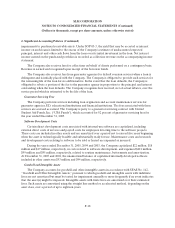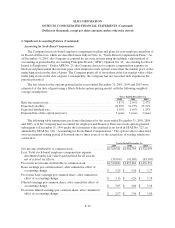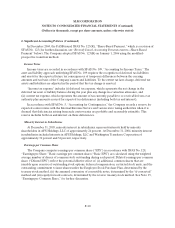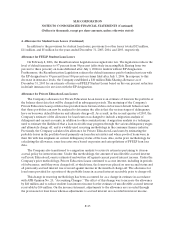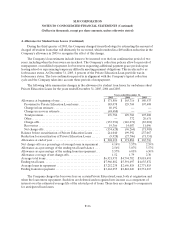Sallie Mae 2005 Annual Report Download - page 138
Download and view the complete annual report
Please find page 138 of the 2005 Sallie Mae annual report below. You can navigate through the pages in the report by either clicking on the pages listed below, or by using the keyword search tool below to find specific information within the annual report.SLM CORPORATION
NOTES TO CONSOLIDATED FINANCIAL STATEMENTS (Continued)
(Dollars in thousands, except per share amounts, unless otherwise stated)
F-16
2. Significant Accounting Policies (Continued)
inception and on an ongoing basis to determine if the amounts received are adequate compensation as
defined in SFAS No. 140. To the extent such compensation is determined to be no more or less than
adequate compensation, no servicing asset or obligation is recorded at the time of securitization.
Derivative Accounting
SFAS No. 133
The Company accounts for its derivatives, which include interest rate swaps, cross-currency interest
rate swaps, interest rate futures contracts, interest rate cap contracts, Floor Income Contracts and equity
forward contracts in accordance with SFAS No. 133, “Accounting for Derivative Instruments and Hedging
Activities,” which requires that every derivative instrument, including certain derivative instruments
embedded in other contracts, be recorded at fair value on the balance sheet as either an asset or liability.
The Company determines the fair value for its derivative contracts using either (i) pricing models that
consider current market conditions and the contractual terms of the derivative contract or (ii) counterparty
valuations. These factors include interest rates, time value, forward interest rate curve and volatility
factors, as well as foreign exchange rates. Pricing models and their underlying assumptions impact the
amount and timing of unrealized gains and losses recognized, and the use of different pricing models or
assumptions could produce different financial results.
Many of the Company’s derivatives, mainly interest rate swaps hedging the fair value of fixed rate
assets and liabilities, cross-currency interest rate swaps, and certain Eurodollar futures contracts, qualify as
effective hedges under SFAS No. 133. For these derivatives, the relationship between the hedging
instrument and the hedged items (including the hedged risk and method for assessing effectiveness), as
well as the risk management objective and strategy for undertaking various hedge transactions at the
inception of the hedging relationship is documented. Each derivative is designated to either a specific asset
or liability on the balance sheet or expected future cash flows, and designated as either a fair value or a
cash flow hedge. Fair value hedges are designed to hedge the Company’s exposure to changes in fair value
of a fixed rate or foreign denomination asset or liability (“fair value” hedge), while cash flow hedges are
designed to hedge the Company’s exposure to variability of either a floating rate asset’s or liability’s cash
flows or expected fixed rate debt issuance (“cash flow” hedge). For effective fair value hedges, both the
hedge and the hedged item (for the risk being hedged) are marked-to-market with any difference recorded
immediately in the income statement. For effective cash flow hedges, the change in the fair value of the
derivative is recorded in other comprehensive income, net of tax, and recognized in earnings in the same
period as the earnings effects of the hedged item. The ineffective portion of a cash flow hedge is recorded
immediately through earnings. The assessment of the hedge’s effectiveness is performed at inception and
on an ongoing basis. In general, regression testing is performed to assess hedge effectiveness. When it is
determined that a derivative is not currently an effective hedge or it will not be one in the future, the
Company discontinues the hedge accounting prospectively and ceases recording changes in the fair value
of the hedged item.
The Company also has a number of derivatives, primarily Floor Income Contracts, certain Eurodollar
futures contracts and certain basis swaps, that the Company believes are effective economic hedges but are
not considered hedges under SFAS No. 133. The Floor Income Contracts are written options which under
SFAS No. 133 have a more stringent effectiveness hurdle to meet. These derivatives are classified as


